Rebuilding the Anaheim Ducks from Home-Grown Parts

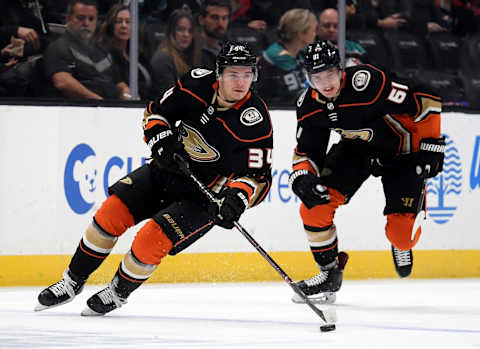
The Anaheim Ducks currently have plenty of pieces to set a rebuild in motions with homegrown parts.
The pseudo-playoffs are over and the COVID-cup playoffs are approaching round 2. It’s noticeable and lamentable that our Anaheim Ducks are not part of it. There are a number of “why’s,” as to why this is the case, but let’s not worry about that. That concern is for the worrywarts amongst us. After all, that’s all in the past, and baby, I’m all about the future.
In order to move forward to the glorious utopia that is perennial cup contender-ship, we need to take stock of what the Ducks have in hand at this very moment. What the lay of the land is, so to speak. At present, the Anaheim Ducks, according to rosterresources.com, have the 10th oldest list in the league, with their top 20 players ranked as the 9th oldest group in the league. Only two other teams have an older forward group.
Further, when breaking the playing group into age brackets, the Ducks have no current players younger than 20 years of age and only three aged between 20 and 24 years of age, which ranks them =17th for teams in this age range. At face value, this suggests that the Anaheim Ducks have not embarked upon a true rebuild just yet.
If anything, that the Ducks currently have 10 players aged between 25 and 29 years of age suggests that they are in the heights of their current powers. Only 11 teams have more players in this age range and each of them is currently playing hockey.
That the Ducks are presently aged to be a successful team and that they are not, may suggest that the players in this age range are not good enough, or that there is a disconnect between coach and player group. Whichever it is, it should be clear from the roster construction, that a shakeup is needed. A transition to a younger team is needed.
It should be noted here, before we go too deep down that rabbit hole, that the defensive group is in a better place than the forward group in terms of age and potential growth. As of the final regular-season game this year, the Anaheim Ducks blue line is the 2nd youngest in the league.
Certainly, players like Cam Fowler and Josh Manson are getting older, yet they aren’t in Zdeno Chara or even Shea Weber territory. They have years of play left in them and likely won’t be greatly affected by the ravages of age just yet.
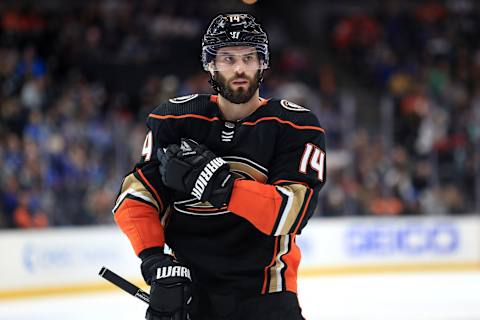
Forward Planning
At 29-years-old, the Anaheim Ducks should begin forward planning for the day they are no longer the quality hockey players they are now. Yet, the Ducks may still have 4 years or so left of them commanding top-4 roles, so there’s no pressing need to make moves immediately to shore up the position.
Thus, with all of that said, while increasing the talent levels all over the ice should certainly be on the agenda for a team that ranked in the bottom 10 for goals-against and goals-for per game, it seems most likely that the forward group needs the most work moving forward.
It is also worth noting that the Seattle expansion draft will take place in June 2021. There are certain league requirements that will arise as part of that draft, and due to that, it is assured that the Ducks will lose at least one player if they don’t make a trade.
At present, it could be hypothesized that the Anaheim Ducks will protect seven forwards and three defensemen, as opposed to eight players of any position. John Gibson is very likely the goalie who will be protected, though the Ducks will still be required to sign a netminder prior to that date who will be expansion eligible, so to become compliant with the league mandate. While exactly who will be protected remains in doubt, and we can quibble it, for now, the Ducks have the following notable players who would be available to Seattle should they not be protected.
Forwards (9): Adam Henrique, Jakob Silfverberg, Rickard Rakell, Max Jones, Troy Terry, Sam Steel, Dan Heinen, Sonny Milano, Isac Lundestrom
Defencemen (5): Cam Fowler, Hampus Lindholm, Josh Manson, Jacob Larsson, Brendan Guhle
Netminders (1): John Gibson
Players such as Josh Mahura, Christian Djoos, and Ryan Getzlaf, are currently signed but are not signed for the 2021-2022 season, which they are required to be to be eligible for expansion. In the case of Mahura and Djoos, it can be expected that they will be extended in due time, however, this would then mean that they will be exposed to the draft.
Getzlaf, as a UFA, can simply remain unsigned until after the expansion draft date and sign with the Ducks after that, thus meaning they would not have to use a protection spot for him. Players like Max Comtois, Benoit-Oliver Groulx, Brayden Tracey, and Trevor Zegras will not be available to Seattle, though they could play as early as next season for the Anaheim Ducks.
Thus, over the next season, hard decisions will need to be made on which players the Ducks would like to protect and how they might best fit into the team going forward. This would be true without the impending expansion draft, however, that they may lose a player without compensation should drive the fact-finding mission a little more strongly.
With a new group of young players, led by Zegras, soon to enter into the line-up consideration, the Ducks need to decide who will become surplus to needs. More to the point, which of these players can command roles in a cup-winning utopic dynasty?
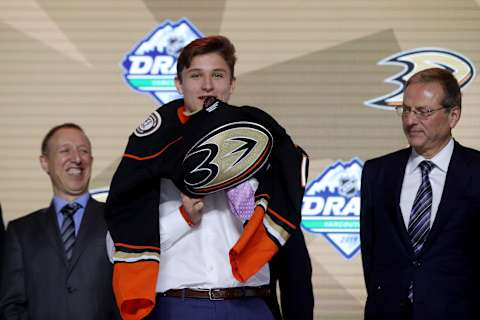
How Do The Anaheim Ducks Line Up Now?
At present, the Anaheim Ducks depth chart and contract situation can be easily determined by scoping out their page on CapFriendly.com. While each has some differing opinions about how that might look in practice, it’s not a great stretch to imagine that the Anaheim Ducks are short on goal-scoring prowess.
They’ve drafted only two 30-goal scorers (Kyle Palmieri and William Karlsson) in the Bob Murray era, neither of whom scored those goals with the Ducks. With Bobby Ryan and Corey Perry no longer with the team, the Ducks are largely lacking in genuine goal-scoring threats. Adam Henrique and Jakob Silfverberg are largely a lock for somewhere in the range of 20-25 per season, yet they will both be 30 years of age this coming season and shouldn’t necessarily be relied upon to carry the scoring load over the next few seasons.
While both Henrique and Silfverberg are currently near essential players for an extremely impotent offense, thoughts should be directed to the future regarding when, or even if, the Ducks should attempt to move on from them. Though that’s a discussion for later in the piece. It’s enough now to consider options.
In terms of playmakers, the Ducks boast Ryan Getzlaf as an older statesman who’s best days are very likely behind him. Nonetheless, Getzlaf will command a top 6 position for at least the next few seasons should he deign to extend his tenure with the Ducks.
The Anaheim Ducks also have Trevor Zegras in the fold, who is one of the superior playmakers not yet in the NHL. It remains to be seen where he will line up for the Ducks and if he’ll be able to carry his success thus far into the NHL, yet hopes and expectations are sky-high.
The rest of the Ducks forward group is more based around the two-way play type of forward. Not truly elite in any one aspect of offensive play, yet no slouches. Unfortunately for the Ducks, two-way doesn’t necessarily win championships. A great many Stanley Cup teams, or even finals teams, have elite players who can win games off their own backs when the going gets tough.
For the Anaheim Ducks to claw their way back up to the top, they’ll need to find a couple more of those difference makers. Though that doesn’t necessarily mean those two-way players are chopped liver and can’t be used. It’s merely a matter of how best to utilize them.
Given that the Ducks youth largely showed they weren’t top 6 scoring options last season, it’s maybe best to start any rebuild with what is currently in hand. That is to say, a potentially solid middle 6 group that requires few additions and a pretty good 4th line.
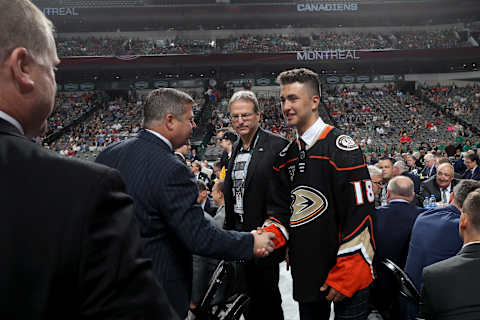
Lining Up The Spine
Starting with the center position the Ducks currently have Sam Steel, Isac Lundestrom, and Benoit-Oliver Groulx all ready to occupy a position on the Anaheim Ducks. Steel has played the last two seasons with the Ducks, which has him accumulating 33 points in 87 games (0.38 point per game pace). Given Steel’s hype as a point producer prior to entering the NHL (1.31 point per game pace in the WHL), the limited production may be considered somewhat disappointing.
Sam Steel
While the hope might be that he can develop into a similar style of pivot as Henrique, it should be noted that Henrique did have a faster start as an NHL scorer than Steel has thus far. Though it should be noted that Steel put up points in the AHL at a comparatively quicker pace (Henrique: 0.68; Steel: 0.77) in their respective first seasons. Henrique carried that over to the NHL in his first full season of NHL hockey (0.69 ppg) than Steel did (0.34 ppg).
Of course, Henrique had a poor sophomore season before settling into a becoming a regular ~40 point player. At 22-years-old (23 next season), Steel still has time to build upon his offensive game, yet time may be running out on the hope that he can be a top 6 pivot. Even in today’s NHL, the question should be asked whether a ~40 point player is the type of player a successful cup team desires as a 2C.
Thus, the Ducks will need to decide whether he is the 3C that they want to run with, in terms of roster construction. Do they foresee the 3rd line being a scoring line, an energy line, or a defensive line, as they move into the future? Does that vision marry up with the other players the Ducks have in hand?
Isac Lundestrom
Like Steel, Lundestrom has also played in parts of the past couple of seasons for a total of 6 points in 30 games (0.20 point per game pace). Never considered to be an offensive savant, prior to the draft Lundestrom was known for his steady playing style. A style that would have him top out as a defensive forward who could potentially put up a few points.
Over the past few years, Lundestrom hasn’t developed a strong offensive game, and it appears that his draft status will remain relatively true to form. It should be noted, however, that his AHL scoring rates did improve this past year under Kevin Dineen‘s tutelage.
Unfortunately, Lundestrom perhaps hasn’t been the strongest on the defensive side of the ledger either. Traditionally speaking, Lundestrom works hard, skates hard, shows a good knowledge of the game, and an ability to intercept passes and break up the play. Perhaps it would be in the player’s best interests to focus on these things and to further add strength to his body so that he can absorb contact to a greater degree.
These skills and this particular weakness may present clues into his performances to date. Despite presenting relatively strong shots-against numbers overall, which are likely a result of his skillful ability break up plays, high-danger chances have been sky high on his shifts. This may be partially due to bigger and stronger players being able to bully themselves to the front of the net.
As a result of having a weak offensive game and relatively underwhelming defensive metrics, Lundestrom’s expected goals-for percentage has been amongst the lowest of all Ducks forwards (39.23 per 60 minutes of play). For those who care about such things, his plus-minus has been below par as well.
At 20 years old, Lundestrom has some time to figure it out, however, with the expansion draft impending and with other players coming into the system, his time may be shorter than it would otherwise be.
Benoit-Oliver Groulx
Of the players who are currently in the system but not on the NHL roster, Benoit-Oliver Groulx is the last of the Anaheim Ducks notable young stable of center-ice-men. Like Steel and Lundestrom before him, there is significant hope that Groulx will be able to make a significant impact with the club. Though I do not believe the average fan is talking about him as much as they should.
Though we are yet to see him at the NHL level, his work in the QMJHL has been strong, both as a point producer and as a defensive worker. Coming in with good size, a strong work ethic, and an ability to play on both sides of special teams, this should earn him the opportunity to play in the NHL sooner than later.
With that said, assuming the Anaheim Ducks choose to test out Lundestrom and Steel this coming year, Groulx may see his ice time predominantly spent in the AHL, which may be the best landing spot for him. It would be really nice to see him generate a friendship and chemistry with the Ducks’ best prospect, Trevor Zegras.
Thus, given those three players are the next in line for the center slots, it would make sense to perhaps consider running with Groulx as an energy line forward who can take care of defense as well as being able to punch back as a point producer.
The kind of two-way player that may best make a home on the 3rd line, depending on his offensive upside. Steel muddies the water a little bit as his best home could be as an offensive-minded 3C, which could bump Groulx down to a 4th line role. In this scenario, I would not see a steady point producing defensive forward leading a pure shut down line, but an opportunity to run four lines with relatively even minutes.
Consider that there is very little difference in minutes played, between the best and the worst of the Carolina Hurricanes forwards. The Ducks (and the Hurricanes) will still want the stars to carry the load, but they would no longer have it demanded of them, as it has been in the past.
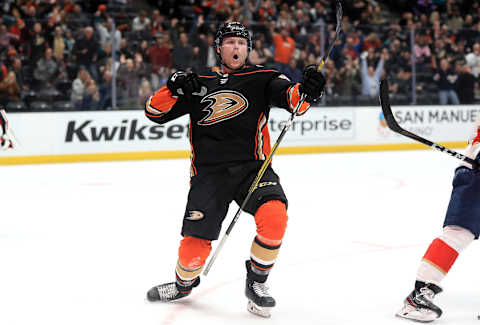
The Anaheim Ducks Already Have Shutdown Wingers
With a number of directions they could work towards, given the Anaheim Ducks current centers in the system, the planning towards what each line may be constructed to do may then be somewhat dictated by the wings in the organization.
Troy Terry
For instance, on the wings, Troy Terry has underwhelmed as an NHL scorer in the combined three seasons he’s played in the NHL, yet has shown considerable growth in his defensive game. His play in transition makes him an offensive threat, yet his relatively weak shot and passing skills have a toothless feel.
Moving him into a bottom-6 role alleviates the pressure of him being a primary scoring option and allows him to focus on the defensive play he is so good at. The lower level of competition he would likely face may also open up his scoring abilities if he can capitalize. This would make him an incredibly useful, and even dangerous, player for the Ducks to ice on any given night.
Intrinsically, now that the “Terry as a top-6 scoring option” experiment is complete, it would seem that Terry is best suited to fit on a line with a player like Groulx who is himself a two-way threat. With both players showing good defensive chops at such a young age, they should easily be able to improve upon that and become a strong duo who can be asked to shut opposition forwards down.
While Groulx’s offensive game is currently uncertain in the NHL, he projects as a relatively strong scorer (PNHLe ranks him as a potential 2nd-liner), whereas Terry too has some attributes that are interesting transitioning the puck from defense to offense. The questions then are whether the Ducks have a third player who would compliment them and whether this duo would be better suited to a third- or fourth-line role.
Max Jones
Max Jones may be another who could be suited to this role on the opposite wing. Known in junior as a quick skating bull-at-the-gate style of scorer, Jones has failed to live up to his draft billing. The Anaheim Ducks as a franchise certainly need to take a lot of the responsibility for this, as they gave him minimal ice time in the top-6 and nearly nothing on the power play.
However, Jones himself didn’t do a lot to put himself on the map and demand that much-vaunted position. It can be said that Jones didn’t receive much puck-luck, and he did produce a relatively high number of rush attempts (only Henrique and Silfverberg remain of players who produced more). What Jones did manage to do was cement himself in the top few players on the Ducks roster with regards to preventing scoring chances.
As a result, the on-ice expected goals against ratio was heavily tilted in favor of Jones. Only Terry, of the regular skaters (and soon to be regular, David Backes, in his 6-game sample) presented superior metrics.
Jones-Groulx-Terry
On a poor defensive team, these numbers may not mean too much, however it should be considered alongside Terry and Jones both being very young to be tasked with defensive assignments. It would be relatively rare for these types of players to supersede their veteran counterparts. This gives hope that, should they pursue this type of role, that they would eventually begin to excel at it, even amongst their older peers on more successful defensive teams.
What makes them dangerous is their ability to skate and put pressure on the opposition, as opposed to merely being a defensive unit. With Terry being very adept at shutting down opposition offensive forays and Jones being strong at generating rush attempts, a line with both would then provide the Anaheim Ducks with a potential shut down unit that should be competent enough offensively, to allow the coaching staff to spread minutes amongst the entire forward group.
Being able to manage minutes in the manner should then allow the top-6 forward group to reduce their in-game fatigue and produce better results as a greater number of games are played. Thus, while Terry and Jones individually may struggle to produce in line with the expectations placed upon them prior to reaching the NHL, their contribution to the team’s offense could still be significant.
Thus a two-way “fourth” line of Jones-Groulx-Terry is born. Some would say that this line is too good to be a traditional fourth line, and they’d be right. But we’re paving the way for Duck domination. If our best-laid plans fall through, then it’s nothing to acquire the standard 4th line plugs that flit about the league and move this line into a middle-6 role.

Generating Scoring From The Wings
Given that the line above would be a pseudo-defensive line, Isac Lundestrom could be considered surplus to needs and thus Sam Steel is the other pivot the Ducks have to build around. Given Steel is the guy, it could then be suggested that the Anaheim Ducks build a third scoring line (by nature and by depth chart) around him.
Building Around Sam Steel
Steel’s ceiling is relatively uncertain at this stage, though it appears he’s not cut out to be a top-6 scorer at this stage of his career. It’s a relatively steep drop from 2016-17 when he put up points in buckets and his PNHLe had him pegged as a superstar in the making. Steel himself doesn’t appear to weight his game towards making plays or shooting the puck, rather doing both with similar frequency and ability.
The relatively even approach would perhaps work best with a genuine shooter and a pass-first playmaker, though the Ducks don’t necessarily have that in the wings. What they do have is a couple of middle-6 offensive all-rounders in Maxime Comtois and Brayden Tracey.
It should be noted that the offensive upside of both of these players in still uncertain and that they could easily still be fixtures on a 2nd line in the NHL. However, with the Ducks’ current line up, finding them positions in that setting will be somewhat difficult, and as the Anaheim Ducks continue to draft in relatively high draft slots, the likelihood of them finding players with high scoring upside is also a strong possibility.
Thus, the idea should be to play these players with the still young Steel and hope to generate a dangerous 3rd line. One question is that both players play the left-wing slot, so at this stage, it would be prudent for one of them to start lining up on the right side. As both are left-hand shooters, this would place one of them on their off-wing, though this has been shown on numerous occasions not to necessarily be a negative for scoring wings.
Max Comtois
Comtois is the older one of the two and projects more as a power forward than a player who will beat his opponent with skill. During his short NHL stint this past season we saw him laying big hits to create space for his linemates (Ryan Getzlaf and Devin Shore), as well as grinding hard in the corners.
This could provide the skillful Steel and Tracey room to operate, and provides a clear point of difference to their play styles. Even should Comtois offense not materialize in its own right, his puck support and ability to regain possession will likely open up some avenues for his linemates to score.
He may not entirely be suited to playing with players like Steel and Tracey, however, physical heavy players are often useful pieces in tight close games. He could easily move about the line up to help create space for offensive players struggling to find time and space on a given night.
Brayden Tracey
Tracey is the other wing who the Anaheim Ducks have in hand, who could be part of a scoring line, feasting on lower levels of competition. Drafted as an analytics darling who put up big numbers as a rookie, Tracey fell away this past season. Injuries certainly played a part in that decline, however, Tracey also did not seem to gel with his linemates after being traded from Moose Jaw to Victoria.
The hope would be that he will regain his mojo in the offseason and come on strong when next season starts. However, even as is, Tracey projects as a 2nd line player according to PNHLe. He does need to add some muscle and size to his frame to reach that lofty potential, however, should he not, playing alongside a bigger body in Comtois should do wonders for him.
Where Tracey is interesting is that his goals came from all different plays, including off the rush and off the cycle. His playmaking too, allowed him to beat defenders in multiple ways. It would seem that this versatility would allow him to play in tight off of an established cycle, should Comtois be banging bodies and regain the puck in the offensive zone, as well as moving in off rush attempts created by Steel during a quick transition play.
Thus, a versatile scoring line is created as a “third” line. In many ways, this could project as another team’s second line. However, here we’re reaching for the stars. Like the Groulx led line above, it wouldn’t take much to bump this line up on the depth chart if the stars all align.
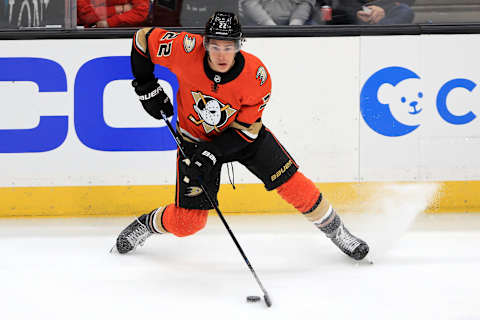
The Top 6 Of The Future
With the bottom-6 group lined up, the Ducks now need to fill in top-6 roster positions. For the next few years, Adam Henrique, Rickard Rakell, Jakob Silfverberg, and Ryan Getzlaf, will all command top-6 roster slots. Though over the next 3 seasons all of these players, bar Rakell, will likely be moved on. In the short term, Danton Heinen and Sonny Milano will likely be afforded the opportunity to show that they should remain Ducks.
Given their relative youth, it is possible that they do command these positions, though they would not likely cut the mustard on a cup contending team in those roles. It isn’t to say it cannot be done with them, but the Ducks should be aiming higher.
Trevor Zegras will eventually slide into the mix, and he could easily be moved between a wing (which I believe him to be better suited to in the NHL) and his regular center position. There’s no reason to think he couldn’t switch in and out with regularity until he’s established himself as dominant in one of those positions.
This season the Anaheim Ducks will also likely draft another top-6 player with the 6th overall draft selection, be it Marco Rossi, Anton Lundell, Alexander Holtz, or another prime time player. When Rakell is included in the mix, the Ducks need only find three more top 6 players and they have time and means to do so.
Potential Lineup Ideas
In this early stage of planning the rebuild the Anaheim Ducks could easily pencil in a line up that looks something like:
XXX-Zegras-XXX
Rakell-Lundell-XXX
Comtois-Steel-Tracey
Jones-Groulx-Terry
It’s a really nice looking line-up. Where the Ducks go from here though is up for debate. Silfverberg is still a productive player, and at worst is a strong two-way threat. While we would be looking into the future and Silfverberg may be considered older, he isn’t necessarily a goal scorer who is going to lose his offensive output in the way a traditional sniper would.
He could easily fit on the Rakell-Lundell line above for the foreseeable future. After all, if Justin Williams can continue playing into his 70’s, then surely Silf can still be useful at 33 years of age. However, should the Anaheim Ducks decide the risk is too great and that they truly want to reach for the stars, then Silfverberg and his teammate Henrique could be flipped for draft selections anywhere from the late first-round through to the early third-round. They’re both productive players and both currently under 30 years of age.
Surplus Pieces
Dan Heinen and Sonny Milano both have uncertain futures with the Ducks. Heinen is the standard “two-way” power forward that the Anaheim Ducks like to have on their roster. However, with Jones and Comtois both being homegrown players with cheaper contracts, and both taking middle-6 “two-way” power forward roles, Heinen could easily be seen as surplus needs moving forward.
It would behoove the Ducks to move him for a future draft pick, thus mitigating the chance of losing a forward player in the expansion draft. Milano has long been touted as an offensive player, tantalizing with his skills. Yet to date, he has scored at only a slightly greater rate than Troy Terry. While the Ducks would enjoy his speed, at 24-years of age, Milano may have reached the peak of his offensive prowess. His defensive liabilities could be overlooked should he score with aplomb, however, this has yet to be the case yet given his 0.38 point per game pace as evidence. The Anaheim Ducks may be best to dangle Milano as trade bait.
Given Steel and Groulx are our preferred centers for the 3rd and 4th lines, Lundestrom will be the center prospect left over. Given his relative youth and high draft billing, the Duck could consider flipping him for a draft pick, and once more, mitigating the risk of losing a player to expansion for nothing. One consideration would be to enter discussions with Seattle regarding them acquiring Lundestrom and perhaps Milano, for a late first-round selection or a second-round selection, with the agreement that they then select a player the Ducks do not necessarily require moving forward.
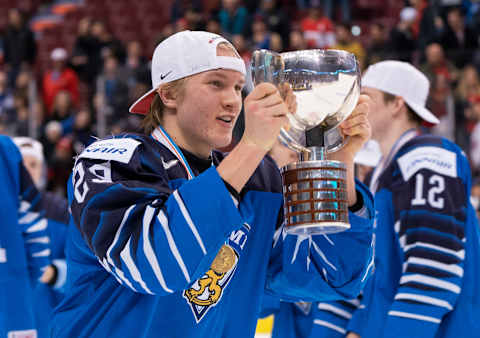
The Final Pieces From The Draft
Taking the above into consideration, as well as the knowledge that the Anaheim Ducks already hold Boston’s first-round selection and their own early 2nd-round selection this season, it would appear that the Ducks will be drafting in this portion of the entry draft time and again over the next few seasons.
This isn’t necessarily a bad place to draft future stars if we consider that future NHL players, Arthur Kaliyev and Akil Thomas, have been drafted by a rebuilding LA Kings team in the 2nd round these past two years.
Both of these players have gone from strength to strength and are currently considered on track to be top-line forwards. Kaliyev in particular, scored so prolifically this past season PNHLe has him pegged as a potential superstar scorer. Alex DeBrincat is another who slipped through the cracks to be taken in the 2nd-round, and who has gone on to score 40 goals in the NHL.
Given the Anaheim Ducks would have their bottom-6 forward all locked up and all young of an age, they would then be able to take wild swings at boom or bust options like Kaliyev or DeBrincat, to round out their top 6 forward grouping.
In this current draft, there would appear to be more steady forwards on offer in the mentioned range, however, two players could stand out. Firstly, the unlikely to still be available, Hendrix Lapierre has had an awful run of injuries and could slide down to the later part of the 1st round. Noel Gunler is the second player who stands out who could slide down the draft order.
He clearly has the offensive chops to be a star scorer in the league and could slide due to perceived attitude issues. Both players would likely not be on the Anaheim Ducks radar in a normal drafting year, but both have high upsides and could be considered with the Boston selection should they still be available should the Ducks deign to take a risk.
While some pundits would concern themselves with a lack of defensive players in the Ducks prospect pool, it should be mentioned that the Ducks currently have their own 2nd round pick this season, which could be used to acquire a defenceman such as Helge Grans, Justin Barron, Shakir Mukhamamadullin or even William Wallinder, should he drop.
None of these players projects as a top-pairing player, but all look to sit around the second pairing. Next season’s draft looks to be a lot heavier on defencemen, and the Ducks could look to bolster their blue line there. It’s worth mentioning once more that the Ducks top defencemen are not particularly old today, and as such the Anaheim Ducks have time to transition to a younger top-4 unit.
Lindholm will still certainly be useful in 4 years, whereas they merely need to plan to move on from Fowler and Manson at present. In 4 years time, they will be 33-years-old and could still be very functional players.
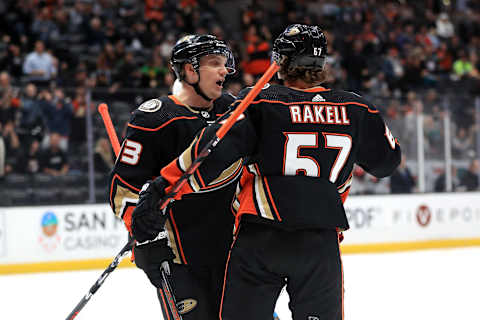
Concluding This Thesis
With all of the above said, the Anaheim Ducks have managed to accrue a bottom 6 group that would be the envy of many teams around the league. They have one clear piece of a future top 6 in hand and could easily find another in this year’s draft with the 6th overall selection. Rakell, as well, is still young enough to be part of the team for another half-decade or more.
There is even some hope that the current prospect pool could grow into true second-line players. The Ducks’ best defencemen are still young enough that they should be useful for the next four years or more. Not necessarily in a top pairing role, but certainly part of a strong defensive unit. John Gibson mans the net for now, and Lukas Dostal appears to be his heir apparent.
Taking that on board, the Ducks have a foundation they can springboard forward from. However, it may require a change of strategy. Instead of taking the safe bet and attempting to merely draft certain NHL players, the Ducks should maybe consider taking the long odds and drafting a potential superstar.
Instead of making safe trades with minor pieces, perhaps they go big and swing for the fences. They only require but a few key pieces, and it would seem that they could acquire in the first couple of rounds between this season’s draft and the 2022 entry-level draft (I’m not ever letting my Brad Lambert love go).
More from Ducks News
- Who could the Anaheim Ducks consider presenting offer sheets to?
- Is Pierre-Luc Dubois on the cards for the rebuilding Anaheim Ducks?
- Making the case for the Anaheim Ducks to trade with the Edmonton Oilers
- Anaheim Ducks might benefit tremendously by trading John Gibson
- How close are the Anaheim Ducks to becoming contenders again?
A strong 2nd line center in this seasons draft, a strong top-pairing caliber defenceman in next seasons draft, and a goal-scoring wing in the 2022 draft should be the plan with their first-round selections. Picking up a boom or bust scorer, a power-play quarterback, and a steady second pairing defenceman may round out any additional selections they may have over those years.
Boom or Bust
With that given, it would appear that only the “boom or bust” scorer is the one they would need to gamble on. With that said, the Anaheim Ducks have been in the lottery mix the past two seasons and could be again in the next two. Should they be in a position to draft Aatu Raty with the first overall selection in 2021 or one of the three-headed monster draft (Wright, Savoie, or Lambert) in 2022, all best-laid plans would be thrown out and those players would be the new building blocks. This would be particularly true of Wright or Lambert, who are easily outstripping their 2021 draft comparables despite being younger in age.
Thus, in conclusion, a large scale rebuild and blowing it all up sounds like a good idea. Afterall more draft selections mean more bites of the cherry. This is particularly true of the future 2022 draft, which appears to be a super draft at the top end. Though it can be said that the Anaheim Ducks already have a foundation in place that will not necessitate them selling the farm.
By moving one or two pieces for draft picks over the next two seasons they will be getting much younger in the forward grouping, which by default will likely increase the variability of their performances. This could help their own draft selections be taken earlier, as well as adding additional chances to draft to needs.
With just a few smart moves and one big risk to needing to pan out, and the Anaheim Ducks could easily see themselves having the cattle to claw their way back into cup contention in a few year’s time. That could be true even without landing in the top-3 draft selections. From there… well, they’ll just need to hire a coaching staff to put all the pieces together.
Next. 2020 Draft Profile: Anton Lundell. dark
Are you a passionate Anaheim Ducks fan that loves reading Pucks of a Feather? If so, we would love to have you on board as a contributor! Just follow the link above for more information on how to join the crew.